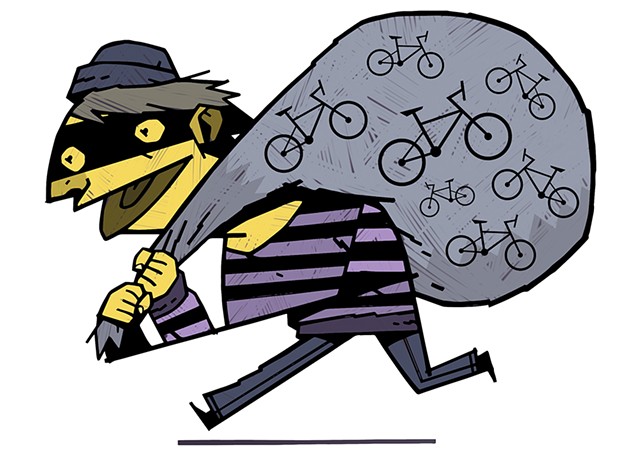
- Thom Glick
In the summer of 2015, Dustin Eager was working at Burlington bar Red Square after graduating from the University of Vermont. He'd recently bought a bike for the first time and was enjoying local explorations on two wheels. He'd usually bring the bike inside while he was at work, but one evening after a late shift, he left it chained up overnight on Church Street and caught a ride home.
"I came back the next day, and one of the wheels was missing," Eager said. He went home to get his car and came back to pick up the bike; by that point, the other wheel and the seat had been swiped, too.
The warm weather waned, and it was several months before Eager decided to replace the missing parts. Eventually, he went to Old Spokes Home, found some new wheels and learned how to fix up the bike.
Eager said to himself, "'I'm going to use this as an opportunity to become an amateur bike mechanic,'" he recalled. "I was so proud of myself."
Roughly three weeks later, after Eager locked up the bike on Church Street again, someone cut his cable lock. This time, the whole bike was gone.
Eager's story is not unusual in Burlington. Local Facebook and Front Porch Forum pages are full of missing bikes. Bikes have disappeared from backyards, downtown bike racks and the UVM campus. Some bikes were unlocked, but others were absconded by thieves who cut locks, removed tires and even hacked through the wooden bars of porch railings. It's so common that it's become a punch line, a meme, a Burlington Thing.
But bike theft isn't unique to the Queen City. According to estimates by 529 Garage, a bike registry website, more than two million bikes are stolen every year in the U.S. — and only one in five is reported to the police. Theft puts a dent in bike ridership: 25 percent of theft victims report riding less after the incident, and 7 percent quit cycling altogether.
Bikes are attractive to thieves for many reasons, according to the Arizona State University Center for Problem-Oriented Policing. Bikes are widely available, fairly valuable, inconspicuous to be seen with, and easily flipped and sold. But not all bikes are stolen for resale; sometimes, people just need a ride from one place to another and later abandon the bike.
As with other crimes, there are different approaches to thinking about bike theft, as outlined in a BBC study guide about crime for British students. The individualist approach holds that crime is a choice and a personal responsibility; the collectivist approach, that societal conditions, including poverty and inequality, drive crime.
Most of the efforts around bike theft focus on prevention. When a bike goes missing, there's usually not much anyone can do about it. Eager said he "diligently filed a police report" and scanned Craigslist and local buy-and-sell pages. "I was confident that I was going to catch whoever was going to sell my bike.
"I think maybe these people are a little more savvy than that," he continued. "I definitely would have confronted someone who was trying to sell it. In that respect, I'm almost glad I didn't find it."
Wade Labrecque, a deputy chief at the Burlington Police Department, estimated that the department solves 30 to 40 percent of the bike thefts reported. And though busts of large-scale theft operations may make headlines, as when South Burlington police found 16 bikes in a man's Burlington apartment in August, Labrecque said it's more common that bikes are returned because they're found abandoned.
Ben Emery was a member of the UVM cycling team when two bikes were stolen from the living room of the house in which he lived. A few other items were missing, and multiple other bikes weren't taken, so Emery guessed the bikes were used mainly as getaway vehicles. He and his roommates filed a police report; police found and returned one bike, belonging to a roommate's partner, though Emery said they wouldn't provide any information on how it was recovered.
"I was under the impression that [my bike] was going to be recovered once the police returned the other stolen bike," Emery said. Instead, he got radio silence. "It took a long time to get in contact with anyone who was actually involved in that case, and, once I did, all they said was, 'We don't have anything,'" he recalled.
Emery now lives in Albuquerque, N.M., where his brother recently had a bike stolen. "If we want to solve the problem of bike theft, in my view, it seems like we have to start addressing why the need for theft is present in so many people," Emery said.
For some Burlingtonians, a community-based approach to recovering bikes has actually worked. Daisy Culkins had two bikes stolen from her backyard in the Old North End. She filed a police report but said it didn't seem to go anywhere and that police seemed "a bit dismissive" because she'd waited a week to file the report.
Culkins posted about the bikes in Front Porch Forum and heard from another local, Linnie Miller. Miller asked for photos of the bikes and said she'd keep her ear to the ground. Three weeks after the bikes disappeared, Miller connected Culkins to a post about a bike dumped in someone's yard in Winooski. It was one of her missing bikes. "It was amazing," Culkins said.
Miller, who works at ANEW Place, a low-barrier shelter, said she sees "borrowed" bikes turn up there occasionally, and she spots abandoned bikes and parts scattered along the waterfront bike path. She also spends a fair amount of time on Champlain Black Market and other Facebook groups, and she makes a point to note details about bikes that are reported missing or found.
"I'm just very active in my community, and I've always been," Miller said. She reported reuniting five or six bikes with their original owners.
The advice around dealing with bike theft is generally similar from all sources: Invest in a quality lock, bring bikes inside when possible, write down the serial number (usually found by flipping the bike upside down and inspecting the joint where the pedal cranks meet), and take photos of the bike.
Patrick McGinn, a manager at Old Spokes Home, said the serial number and photos can help people identify their bike if it's stolen and turns up abandoned or in a shop. A receipt from purchase can also help. As for preventing the theft, he emphasized the quality of the bike lock, the location in which the bike is locked and the length of time it's left there.
"If you have the best bike rack ever and you leave your bike there for two weeks, at some point someone's going to notice," McGinn said. "It sucks, and it's a shame, but it is going to happen. Really the best thing we can do is to educate people."












Comments
Comments are closed.
From 2014-2020, Seven Days allowed readers to comment on all stories posted on our website. While we've appreciated the suggestions and insights, right now Seven Days is prioritizing our core mission — producing high-quality, responsible local journalism — over moderating online debates between readers.
To criticize, correct or praise our reporting, please send us a letter to the editor or send us a tip. We’ll check it out and report the results.
Online comments may return when we have better tech tools for managing them. Thanks for reading.